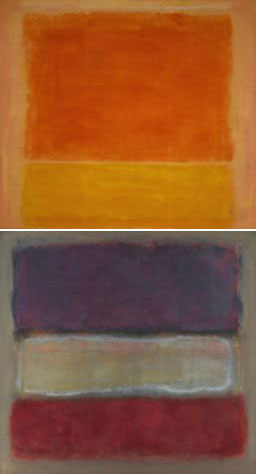"What do you see?" That is the question that Abstract Expressionist artist Mark Rothko asks his assistant in RED. The Tony-winning play, which opens at the Goodman Theatre on Tuesday Wednesday, is a two character bio-drama based on the events surrounding Rothko's 1958 commission for the Four Seasons restaurant in New York. Written by former Chicagoan Josh Logan, RED explores the philosophical and emotional connections between an artist and his work while onstage the actors work on an actual canvas.
The commission—to provide 600 square feet of colorfield murals for the new, swanky restaurant at the Seagrams Building in New York—was the most prestigious public offer ever made to an Abstract Expressionist. It promised Rothko a lucrative ($35,000) and prominent opportunity. Yet, in 1959, after the murals were completed, Rothko abruptly returned the money and held on to his paintings.
In the mid-1960's, he gave nine of the murals to the Tate Modern in London,insisting on a permanent display room and resisting any attempt by the Tate to integrate them with other examples of his work. The Rothko Room opened at the Tate in 1970 and Booker Prize-winning novelist wrote that it is "the strangest, most compelling and entirely alarming experience to be had in any gallery anywhere." Other Seagram murals went to Kawamara Memorial Museum in Japan and to the National Gallery of Art in Washington, D.C. In 1970, Rothko committed suicide in his Bowery studio; his body was found lying in an eight by six foot pool of blood—a "colorfield" appromixately the size of his paintings.
Reproductions of Rothko's paintings abound, from furniture dealer Room & Board to poster shops. The colorfield style—floating rectangles of color—are highly decorative, but that was far from the artist's purpose. "If you are only moved by color relationships, you are missing the point," he once said. "I am interested in expressing the big emotions—tragedy, ecstacy, doom."
But for people interested in experiencing for themselves the emotional pull of the paintings, the question becomes: Where can you view an original Rothko?
In the Midwest, the number of Rothkos paintings are limited. The late art collector Muriel Newman, profiled in Chicago in 2009, had what was considered the greatest personal collection of Abstract Expressionists, including a number of Rothkos. When she lived in New York during the 1950's, she had befriended a number of artists and had even purchased a Rothko "hot off the easel" after running into Rothko one day on the street. Newman lived most of her life in Chicago, but she gave the majority of her collection in a bequest to the Museum of Modern Art in New York. Her reasons, detailed in the profile, were complicated. In part, she always maintained that she wanted the collection to go back to New York where the paintings had been created.
The Art Institute of Chicago owns six Rothkos and two of them are currently on display (right), including the magnificent Purple, White, Red. And the Smart Museum of Art at the University of Chicago has a mid-1960's red-on-orange Rothko on display.
If you're willing to travel, you can catch a Rothko at the Milwaukee Art Center. The Walker Art Center in Minneapolis has six Rothkos, showing his range from figurative art in the mid-1940's to his mid-1960's. And the Nelson-Atkins Museum in Kansas City, Missouri, has a later dark field painting by Rothko.
Photograph: Courtesy of the Art Institute of Chicago


